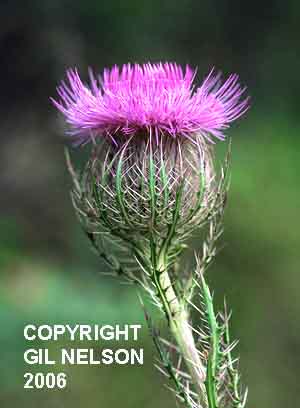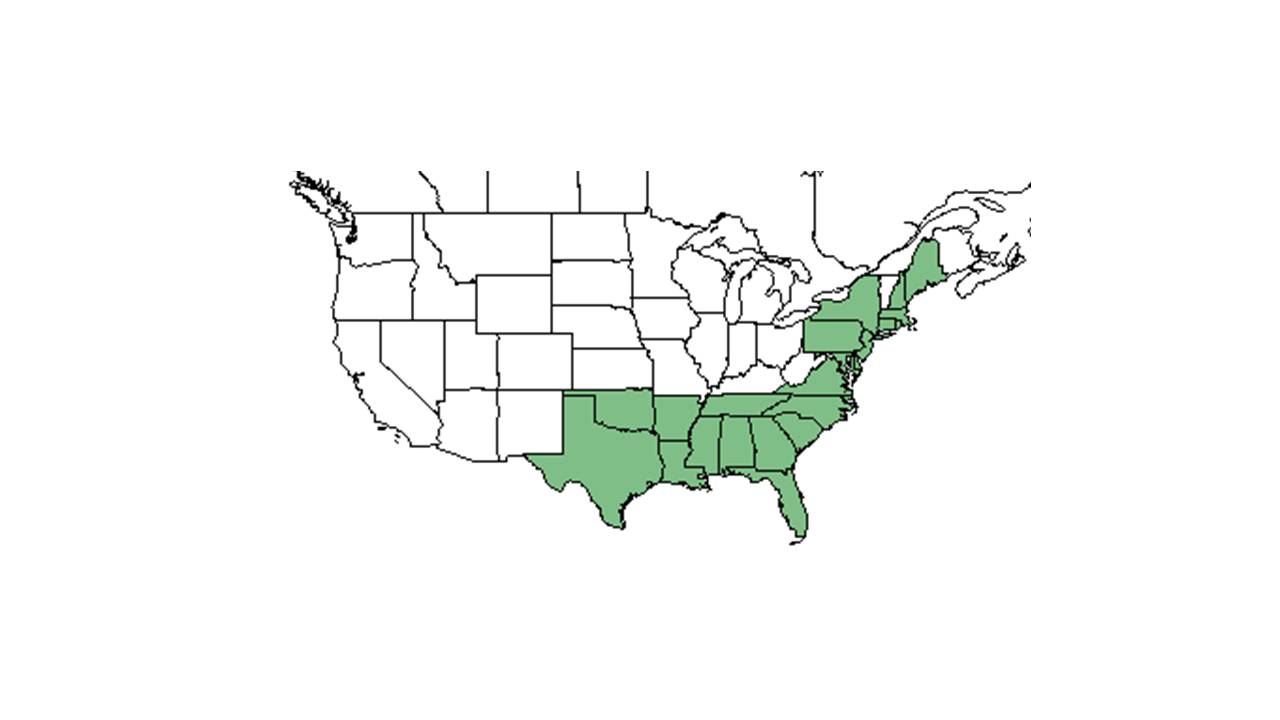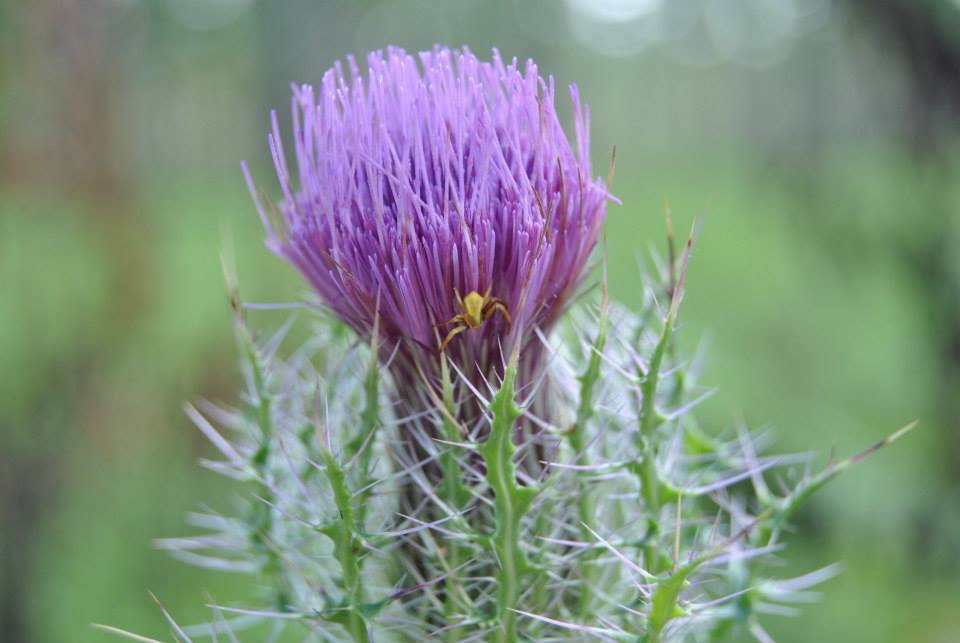Difference between revisions of "Cirsium horridulum"
(→Conservation and management) |
|||
| Line 34: | Line 34: | ||
==Ecology== | ==Ecology== | ||
===Habitat===<!--Natural communities, human disturbed habitats, topography, hydrology, soils, light, fire regime requirements for removal of competition, etc.--> | ===Habitat===<!--Natural communities, human disturbed habitats, topography, hydrology, soils, light, fire regime requirements for removal of competition, etc.--> | ||
| − | It has been found in pine-wiregrass woodlands, savannahs, pine-scrub oak woodlands, juniper-pine-palm woodlands, longleaf pine-turkey oak barrens, pine hills, cabbage palm hammocks, and along streams and marshes. This species has also been observed in human disturbed habitats such as roadsides, weedy fields, waste grounds, ligand fields, flat spoil areas, shallow watered ditches, pine plantations, and frequently mowed areas. Takes to the moister soil below longleaf pine-scrub oak forested sand hills and occurs in open light conditions in loamy sand or peat, loose sand, and drying loamy sand. Usually inhabits moist open areas between either drier or wetter conditions and may be present in well-drained uplands and limestone substrate. <ref name="fsu"/> Associated species include ''Pinus palustris, Quercus laevis, Melanthera, Eleocharis, Juncus, Xyris'', and others. <ref name="fsu"/> | + | It has been found in pine-wiregrass woodlands, savannahs, pine-scrub oak woodlands, juniper-pine-palm woodlands, longleaf pine-turkey oak barrens, pine hills, cabbage palm hammocks, and along streams and marshes. This species has also been observed in human disturbed habitats such as roadsides, weedy fields, waste grounds, ligand fields, flat spoil areas, shallow watered ditches, pine plantations, and frequently mowed areas. Takes to the moister soil below longleaf pine-scrub oak forested sand hills and occurs in open light conditions in loamy sand or peat, loose sand, and drying loamy sand. Usually inhabits moist open areas between either drier or wetter conditions and may be present in well-drained uplands and limestone substrate. <ref name="fsu"/> It is considered a facultative upland species that usually is found in non-wetland ecosystems, but can grow in wetlands as well.<ref name= "USDA"/> |
| + | |||
| + | Associated species include ''Pinus palustris, Quercus laevis, Melanthera, Eleocharis, Juncus, Xyris'', and others. <ref name="fsu"/> | ||
===Phenology=== <!--Timing off flowering, fruiting, seed dispersal, and environmental triggers. Cite PanFlora website if appropriate: http://www.gilnelson.com/PanFlora/ --> | ===Phenology=== <!--Timing off flowering, fruiting, seed dispersal, and environmental triggers. Cite PanFlora website if appropriate: http://www.gilnelson.com/PanFlora/ --> | ||
Revision as of 19:44, 5 April 2019
| Cirsium horridulum | |
|---|---|

| |
| photo by Gil Nelson | |
| Scientific classification | |
| Kingdom: | Plantae |
| Division: | Magnoliophyta - Flowering plants |
| Class: | Magnoliopsida – Dicotyledons |
| Order: | Asterales |
| Family: | Asteraceae ⁄ Compositae |
| Genus: | Cirsium |
| Species: | C. horridulum |
| Binomial name | |
| Cirsium horridulum Michx. | |

| |
| Natural range of Cirsium horridulum from USDA NRCS Plants Database. | |
Common name: Yellow Thistle
Contents
Taxonomic notes
Synonyms: Cirsium vittatum Small; Cirsium smallii Britton
Varieties: Cirsium horridulum Michaux var. horridulum; Cirsium horridulum Michaux var. megacanthum (Nuttall) D.J. Keil; Cirsium horridulum Michaux var. vittatum (Small) R.W. Long
Description
A description of Cirsium horridulum is provided in The Flora of North America. This species is thistle-like and tends to resprout growing erect to about 1 meter. [1] There are three varieties: horridulum, magacanthum, and vittatum. Var. horridulum is the only variety with yellow flowers, but it may also have red and purple flowers. [2]
Distribution
C. horridulum is found in all the eastern coastal states from Maine to Texas, Tennessee, Arkansas, and Oklahoma. [3] The varieties may have differing ranges: variety C. horridulum is found throughout the species range, except Oklahoma and Arkansas, variety C. megacanthum is found only in the lower Piedmont and coastal plain, and the variety C. vittatum is isolated to the coastal plain. [2]
Ecology
Habitat
It has been found in pine-wiregrass woodlands, savannahs, pine-scrub oak woodlands, juniper-pine-palm woodlands, longleaf pine-turkey oak barrens, pine hills, cabbage palm hammocks, and along streams and marshes. This species has also been observed in human disturbed habitats such as roadsides, weedy fields, waste grounds, ligand fields, flat spoil areas, shallow watered ditches, pine plantations, and frequently mowed areas. Takes to the moister soil below longleaf pine-scrub oak forested sand hills and occurs in open light conditions in loamy sand or peat, loose sand, and drying loamy sand. Usually inhabits moist open areas between either drier or wetter conditions and may be present in well-drained uplands and limestone substrate. [1] It is considered a facultative upland species that usually is found in non-wetland ecosystems, but can grow in wetlands as well.[4]
Associated species include Pinus palustris, Quercus laevis, Melanthera, Eleocharis, Juncus, Xyris, and others. [1]
Phenology
This species has been observed flowering from March to October and fruiting from March through November. [1] The varieties may flower at different times: variety C. horridulum flowers April to June and September with peak inflorescence in April, variety C. megacanthum flowers March to June and variety C. vittatum flowers from February to August. [2][5] Kevin Robertson has observed this species flower within three months of burning. KMR The variety C. horridulum has produced natural hybrids with C. pumilum var. pumilum. [2]
Seed dispersal
Seeds are cypsela that are wind and bird dispersed. [2] This species is thought to be dispersed by wind. [6]
Fire ecology
This species is able to grow in burned old fields.[1]
Pollination
The following Hymenoptera families and species were observed visiting flowers of Cirsium horridulum at Archbold Biological Station. [7]
Apidae: Apis mellifera
Halictidae: Augochlorella gratiosa, Halictus poeyi, Lasioglossum nymphalis, L. pectoralis
Megachilidae: Lithurgus gibbosus, Megachile brevis pseudobrevis
Use by animals
This species is the larval host to the little metalmark (Calephelis virginiensis) and painted lady (Vanessa cardui) butterflies. [8] Members of the Seminole Tribe have been said to use parts of this plant to make blowgun darts.[8]
Diseases and parasites
The leaf epidermis is surrounded by an internal and external cuticle, that reduces the likelihood of a pathogen entering the plan. [9]
Conservation and management
C. horridulum is listed as an endangered species by the Connecticut Department of Environmental Protection, the New Hampshire Division of Forests and Lands, and the Pennsylvania Department of Conservation and Natural Resources. It is also listed as threatened by the Rhode Island Department of Environmental Management. This species is considered a noxious weed by the Arkansas State Plant Board, and the Iowa Department of Agricultire and Land Stewardship.[4]
Cultivation and restoration
Photo Gallery
References and notes
- ↑ 1.0 1.1 1.2 1.3 1.4 Florida State University Robert K. Godfrey Herbarium database. URL: http://herbarium.bio.fsu.edu. Last accessed: June 2014. Collectors: L. C. Anderson, G. R. Cooley, J. R. Eaton, R. K. Godfrey, E. Keppner, L. Keppner, R. Kral, H. Kurz, K. MacClendon, K. M. Meyer, K. Patel, P. L. Redfearn Jr., W. R. Stimson, A. Townesmith, L. B. Trott, K. L. Tyson, and C. E. Wood Jr. States and Counties: Florida: Bay, Calhoun, Dade, Dixie, Escambia, Franklin, Gadsden, Jackson, Jefferson, Leon, Levy, Liberty, Marion, Monroe, Pasco, Polk, Taylor, Wakulla, and Washington. Georgia: Grady and Thomas.
- ↑ 2.0 2.1 2.2 2.3 2.4 [[1]]Encyclopedia of Life. Accessed: April 14, 2016
- ↑ [[2]]U.S. Wildflowers. Accessed: April 14, 2016
- ↑ 4.0 4.1 USDA, NRCS. (2016). The PLANTS Database (http://plants.usda.gov, 5 April 2019). National Plant Data Team, Greensboro, NC 27401-4901 USA.
- ↑ Nelson, G. PanFlora: Plant data for the eastern United States with emphasis on the Southeastern Coastal Plains, Florida, and the Florida Panhandle. www.gilnelson.com/PanFlora/ Accessed: 7 DEC 2016
- ↑ Kirkman, L. Katherine. Unpublished database of seed dispersal mode of plants found in Coastal Plain longleaf pine-grasslands of the Jones Ecological Research Center, Georgia.
- ↑ Deyrup, M.A. and N.D. 2015. Database of observations of Hymenoptera visitations to flowers of plants on Archbold Biological Station, Florida, USA.
- ↑ 8.0 8.1 [[3]]Florida Native Plant Society. Accessed: April 14, 2016
- ↑ Pesacreta, T. C. and K. H. Hasenstein (1999). "The Internal Cuticle of Cirsium horridulum (Asteraceae) Leaves." American Journal of Botany 86(7): 923-928.
